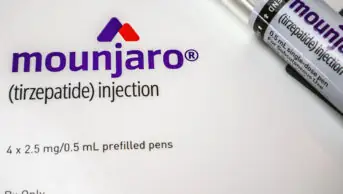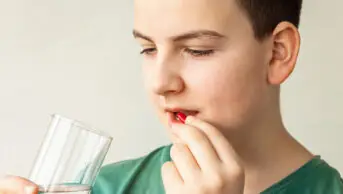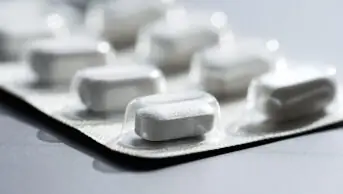
Shutterstock.com
After reading this article, you should be able to:
- Recognise the signs and symptoms of lithium toxicity;
- Understand the risk factors for, and causes of, lithium toxicity;
- Understand the management of lithium toxicity;
- Understand the role of pharmacy professionals in preventing lithium toxicity;
Introduction
Lithium belongs to a class of medicines called mood stabilisers[1]. It is used in acute treatment of mania, maintenance treatment of bipolar disorder, treatment-resistant depression, and treatment of aggressive or self-harming behaviours[2,3]. Lithium is the recommended maintenance treatment for bipolar disorder and there is evidence that it has an antisuicidal effect[4–7].
Prescribing data indicate 60,000–70,000 lithium prescriptions were issued each month in primary care across England between April 2022 and March 2023[8,9]. Annual prevalence of lithium toxicity is thought to be low, at 1–2%, but little is known about the true prevalence owing to a lack of national population-based cohort studies[10,11]. Since 1995, there have been 5,913 adverse drug reaction reports submitted to the Medicines and Healthcare products Regulatory Agency (MHRA) for lithium, 1,624 of which were serious and 96 that were fatal[12].
Owing to its narrow therapeutic index, lithium is classed as a high-risk medicine. In 2009, an audit by the Prescribing Observatory for Mental Health demonstrated that the quality of lithium monitoring for patients in contact with mental health services across the UK fell short of the required standards[13]. These results, along with incident reports, prompted the National Patient Safety Agency (NPSA) to publish a patient safety alert on safer lithium therapy[14].
In 2019/2020, a high-risk medicines audit of 21,883 patients was conducted for lithium as part of the Community Pharmacy Quality Scheme. Of these patients, 34% were not aware of the signs of lithium toxicity and 29% did not know how to prevent it, highlighting patient counselling on lithium as an area of improvement[15].
Pharmacy professionals across all sectors will encounter patients prescribed lithium and have an important role in providing education on recognition and prevention of lithium toxicity.
Initiation
Before starting treatment with lithium, baseline monitoring includes weight and blood tests for urea and electrolytes (U&Es), estimated glomerular filtration rate (eGFR), full blood count (FBC), thyroid function tests (TFTs), and calcium levels[2–4]. An electrocardiogram (ECG) is recommended for patients with cardiovascular disease or other cardiovascular risk factors, such as arrythmias[2–4].
Lithium must be prescribed by brand name; preparations are not always bioequivalent because they contain different lithium salts (see Table)[2,3].
Priadel liquid 5mL (520mg) is equivalent to lithium carbonate 204mg[2,3,16]. Li-liquid 5mL (509mg) is equivalent to lithium carbonate 200mg[2,3,16]. These equivalences can be used when switching between tablet and liquid formulations.
Lithium is initiated at 400mg at night (or 200mg in older people) if using a modified release or immediate release lithium carbonate tablet formulation[1,5]. Once-daily dosing at night may improve adherence through simplification of dosage regimens, and facilitates daytime blood tests, 12 hours post dose. Once-daily dosing may reduce renal damage compared to multiple-daily dosing[17]. Lithium citrate liquid formulations are prescribed twice daily because they are not modified release[3].
Lithium is gradually increased in increments of 100–200mg, depending on lithium levels and patient response[5]. Lithium levels should be checked seven days after initiation, seven days after dose change and then every seven days until the desired serum level is achieved and remains stable[2,3]. Blood samples for lithium levels are taken 12 hours post dose; if a patient is prescribed a twice-daily liquid preparation, the blood sample should be taken just prior to the next dose[2,3].
Target lithium levels are 0.4–1.0mmol/L[2,3]. A lower level (0.4–0.6mmol/L) may be indicated for older patients, those on longer-term maintenance therapy for bipolar disorder or patients being treated for depression[2,3,18]. Levels of 0.6–0.8mmol/L are recommended for patients being prescribed lithium for the first time for acute mania[4]. Higher lithium levels of 0.8–1.0mmol/L may be considered for harder to treat mania[1].
Long-term monitoring
Once stable, lithium levels are checked every three months for the first year and every six months thereafter[2,3]. Patients with risk factors for toxicity should have their lithium level checked every three months for as long as the risk factor remains present. Risk factors include being aged over 65 years, impaired renal or thyroid function, raised calcium levels, taking interacting medicines, poor symptom control, poor adherence or where the last level was >0.8mmol/L[2,3].
Extra lithium levels are indicated when a patient switches between brands; this requires the same precautions and monitoring as when treatment is initiated[16]. A brand switch may be required in the event of supply issues or if a patient requires a liquid preparation owing to swallowing difficulties. Additional monitoring is recommended if a patient becomes acutely unwell, there are significant changes to fluid or sodium intake, or an interacting medicine is started[2,3].
Weight, eGFR, U&Es, TFTs and calcium levels should be monitored every six months[19].
Contraindications and cautions
Lithium is primarily excreted via the kidneys and should not be used in severe renal impairment owing to risk of accumulation[20]. Caution is required in mild or moderate renal impairment, with close monitoring of lithium levels. Lithium can cause thyroid disturbances, such as hypothyroidism and thyrotoxicosis, but it should not be prescribed in untreated hypothyroidism[2,3,20].
Lithium can aggravate Brugada syndrome — a rare heart condition that causes arrhythmias — and is contraindicated if there is personal or family history[2,3]. It should be avoided in cardiac disease associated with rhythm disorders, Addison’s disease, hypersensitivity to lithium or an excipient, and in patients with low sodium levels, including dehydration or low-sodium diets[16].
Lithium must be used with extreme caution, and only under specialist supervision, in pregnancy and breastfeeding[21,22]. There is a risk of foetal cardiac defects if used during the first trimester and more frequent monitoring of lithium levels is indicated throughout the pregnancy and postnatal period[22,23].
Drug interactions
Owing to the narrow therapeutic index, drug interactions have the potential to precipitate lithium toxicity. The following medicines should be avoided if possible. If they must be prescribed, monitor for symptoms of lithium toxicity and measure lithium levels more frequently.
- Angiotensin-converting enzyme (ACE) inhibitors (e.g. lisinopril, ramipril), which may cause up to four times increase in lithium levels by reducing renal excretion and can precipitate renal failure[16]
- Angiotensin II receptor antagonists (e.g. candesartan, losartan), which may cause an increase in lithium levels. They have less effect on aldosterone than ACE inhibitors so a clinically significant interaction is less likely; some manufacturers do not recommend the combination[24]
- Thiazide diuretics (e.g. bendroflumethiazide, indapamide), which may cause up to a four times increase in lithium levels within seven to ten days by reducing renal excretion[24]
- Loop diuretics (e.g. bumetanide, furosemide), which may cause lithium retention and toxicity but lesser risk than with thiazide diuretics. The risk is increased during the first month[24]
- Non-steroidal anti-inflammatory drugs (NSAIDs; e.g. diclofenac, ibuprofen, naproxen), which may increase lithium levels within a few days through renal reabsorption of sodium and therefore lithium. It is preferable to prescribe NSAIDs regularly alongside lithium so levels can be monitored and adjusted; as needed NSAIDs should be avoided[1,24]
- Carbamazepine, which, in combination with lithium, has been reported to cause neurotoxicity[1].
A detailed list of all lithium interactions can be found on Medicines Complete[24].
Side effects
Most lithium side effects are dose and serum level related[1]. The most common side effects at initiation are nausea, diarrhoea and vertigo; they usually resolve within a few days[16]. Other side effects such as fine hand tremors, polyuria and polydipsia may persist[20]. Ankle oedema, metallic taste in the mouth, aggravation of psoriasis and weight gain are also reported[1,20].
In the longer term, lithium can be associated with thyroid disturbances[20]. Hypothyroidism can be treated with levothyroxine and is not a reason to cease treatment with lithium[1]. More rarely, lithium increases the risk of hyperthyroidism and hyperparathyroidism[16].
Longer-term lithium treatment can lead to a decline in GFR in around 20% of people[5,16]. Lithium can also cause nephrogenic diabetes insipidus, with symptoms of polyuria and polydipsia, which may be irreversible after treatment of 15 years or more[1].
Lithium toxicity
Signs and symptoms
Lithium toxicity may occur in some patients despite a normal lithium level; therefore, recognising the clinical features of toxicity is important. Signs and symptoms of lithium toxicity are summarised in Figure 1. The central nervous system (CNS) is most affected in chronic toxicity, with an altered level of consciousness being the most common sign[25]. Other CNS signs and symptoms include lethargy, slurred speech, feeling lightheaded, lack of co-ordination, confusion, syncope, coarse tremor and muscle weakness[16,20]. Patients with acute toxicity (e.g. overdose) may be asymptomatic initially, followed by development of gastrointestinal effects (e.g. nausea, vomiting)[25].
Lithium levels >1.5mmol/L are more often associated with toxicity; severity increases when levels are >2.0mmol/L[16]. Signs of severe toxicity include increased disorientation and seizures, possibly leading to coma[1]. The initiating specialist should provide the patient with written and verbal information on recognising and avoiding toxicity; usually in the form of the NPSA lithium patient information booklet. It is recommended for this information to be repeated by pharmacy professionals in primary care and community pharmacy at regular intervals. Pharmacy professionals in all sectors should be able to recognise signs and symptoms of toxicity when a patient prescribed lithium presents with acute illness or physical complaints.
Possible differential diagnoses for lithium toxicity are presentations with neurological features, altered levels of consciousness and changes in mental state. These include neuroleptic malignant syndrome, serotonin syndrome, intoxication after intake of illicit substances, alcohol intoxication and withdrawal, thyroid dysfunction (e.g. thyrotoxicosis), hypoglycaemia and neurological effects (e.g. stroke, head trauma or infection)[25].
Causes and risk factors
Lithium toxicity can be classified as acute, acute-on-chronic, or chronic[26]. Acute toxicity usually occurs in the context of a single intentional overdose in a lithium naïve patient. Acute-on-chronic toxicity occurs when there is an acute overdose on the background of long-term treatment; this can cause serious toxicity owing to saturation of extravascular tissues with lithium.
Chronic toxicity is usually a complication of longer-term therapy owing to:
- Acute or chronic overdosage (e.g. switching lithium salt with no dose adjustment);
- Febrile illness (e.g. influenza, chest infection, urinary infections, sepsis);
- Dehydration (e.g. diarrhoea, vomiting, hot climates);
- Initiation of interacting medicines;
- Deteriorating renal function[26].
Patients with long-term conditions, including hypertension, Addison’s disease, diabetes, congestive heart failure, chronic renal disease and schizophrenia are at increased risk of developing lithium toxicity[19]. Other risk factors include older age, higher serum lithium levels, low salt diets, alcohol use, female gender and thyroid dysfunction[25].
Management
Lithium levels should not exceed 1.5mmol/L but lithium toxicity may occur at normal lithium levels[16,20]. If a patient presents with a lithium level above their target therapeutic range. a clinical review is indicated to assess for signs and symptoms of toxicity. Consideration should also be given to possible reasons for the high level (e.g. sample taken too close to the last dose, a recent lithium salt change, acute illness, new interacting medicine, incorrect dose taken). Specialist advice can be sought for dose changes and further monitoring recommendations.
If there are signs or symptoms of lithium toxicity, lithium should be withheld, and an urgent lithium level and U&Es should be taken, with specialist advice sought[19]. Referral to A&E may be required, depending on severity of symptoms and certainty of toxicity[16]. Medical assessment is also recommended in the following cases:
- Accidental ingestion of ≥50mg/kg lithium carbonate or ≥100mg/kg lithium citrate;
- Known renal impairment;
- Taking interacting medicines that may cause accumulation of lithium;
- Age ≥65 years;
- Intentional overdose of lithium[26].
All patients presenting to A&E with suspected lithium toxicity should have the following investigations and treatment:
- Lithium should be stopped;
- Monitoring of vital signs;
- 12-lead ECG;
- Blood tests to include FBC, U&Es, liver function tests, TFTs and calcium levels;
- Monitoring of lithium levels;
- Adequate hydration to increase urine output and perfusion;
- Correction of electrolyte abnormalities.
In the case of acute toxicity, gastric lavage is unlikely to be beneficial, but whole bowel irrigation may be considered if >4g of lithium has been ingested by an adult[2,3,26]. Forced diuresis is contraindicated owing to lack of evidence for efficacy[25]. Haemodialysis is recommended in cases of severe toxicity, including:
- All patients with neurological toxicity features (e.g. convulsions, decreased consciousness) or life-threatening dysrhythmias, irrespective of lithium level;
- Lithium level >4.0mmol/L in patients with renal impairment;
- Lithium level >5.0mmol/L without signs of toxicity;
- Lithium level >4.0mmol/L in cases of acute overdose on the background of long-term lithium therapy;
- Lithium level >2.5mmol/L in patients with chronic toxicity[26].
Following acute-on-chronic or chronic toxicity, consideration is given to restarting lithium if the benefits are deemed to outweigh the risks[25]. The timing depends on repeat measures of lithium levels, with guidance suggesting restarting lithium once levels have been below, or within, the therapeutic range for at least 24 hours[25].
Prevention
Providing verbal and written information to patients and carers is critical for preventing lithium toxicity — at initiation and throughout treatment. Following the 2009 lithium patient safety alert, the NPSA developed a lithium patient information booklet, alert card and record book for tracking blood tests. Pharmacy professionals should ensure that these resources are available to patients. They can be ordered online in primary care via Primary Care Support England and secondary care via NHS Forms[27]. Patients should be educated on signs of lithium toxicity and when to seek help. They should also be aware of potential causes for lithium toxicity and how these can be prevented.
Toxicity can be prevented by regular blood tests to check lithium levels. Pharmacy professionals involved in repeat prescribing, or dispensing, of lithium should check that blood tests are being monitored regularly and encourage recording in the patient record book[14]. Pharmacy professionals have a role in preventing lithium toxicity caused by drug interactions, especially in community pharmacy with over-the-counter medicines, such as NSAIDs.
Best practice for pharmacy professionals
- Check that lithium is prescribed by brand. Caution and additional monitoring is needed when changing brands as they may not be bioequivalent;
- Check that patients are accessing regular blood tests for monitoring of lithium levels, eGFR, U&Es, TFTs and calcium levels;
- Ensure patients are counselled regularly when taking lithium; focus on signs, symptoms, and prevention of toxicity;
- Ensure patients have the NPSA lithium patient resources;
- Check for clinically significant drug interactions with lithium; ensure there is a clear monitoring plan if these medicines cannot be avoided;
- Be alert to signs and symptoms of lithium toxicity; refer appropriately for follow up with the GP practice or directly to A&E depending on symptom severity.
- 1Taylor DM, Barnes TR, Young AH. The Maudsley Prescribing Guidelines in Psychiatry. 14th ed. Wiley-Blackwell 2021. https://www.wiley.com/en-gb/The+Maudsley+Prescribing+Guidelines+in+Psychiatry%2C+14th+Edition-p-9781119772224 (accessed February 2024)
- 2Lithium carbonate. British National Formulary. 2023. https://bnf.nice.org.uk/drugs/lithium-carbonate/ (accessed February 2024)
- 3Lithium citrate. British National Formulary. 2023. https://bnf.nice.org.uk/drugs/lithium-citrate/ (accessed February 2024)
- 4Bipolar disorder: assessment and management. National Institute for Health and Care Excellence . 2014. https://www.nice.org.uk/guidance/cg185 (accessed February 2024)
- 5Evidence-based guidelines for treating bipolar disorder: Revised third edition recommendations from the British Association for Psychopharmacology. The British Association for Psychopharmacology . 2016. https://www.bap.org.uk/pdfs/BAP_Guidelines-Bipolar.pdf (accessed February 2024)
- 6Cipriani A, Hawton K, Stockton S, et al. Lithium in the prevention of suicide in mood disorders: updated systematic review and meta-analysis. BMJ. 2013;346:f3646–f3646. https://doi.org/10.1136/bmj.f3646
- 7Wilkinson ST, Trujillo Diaz D, Rupp ZW, et al. Pharmacological and somatic treatment effects on suicide in adults: A systematic review and meta‐analysis. Depression and Anxiety. 2021;39:100–12. https://doi.org/10.1002/da.23222
- 8Lithium Carbonate (0402030K0). OpenPrescribing. 2023. https://openprescribing.net/chemical/0402030K0/ (accessed February 2024)
- 9Lithium Citrate (0402030P0). OpenPrescribing. 2023. https://openprescribing.net/chemical/0402030P0 (accessed February 2024)
- 10Heath LJ, Billups SJ, Gaughan KM, et al. Risk Factors for Utilization of Acute Care Services for Lithium Toxicity. PS. 2018;69:671–6. https://doi.org/10.1176/appi.ps.201700346
- 11Ott M, Stegmayr B, Salander Renberg E, et al. Lithium intoxication: Incidence, clinical course and renal function – a population-based retrospective cohort study. J Psychopharmacol. 2016;30:1008–19. https://doi.org/10.1177/0269881116652577
- 12Interactive Drug Analysis Profile: Lithium. Medicines and Healthcare products Regulatory Agency. https://yellowcard.mhra.gov.uk/idaps (accessed February 2024)
- 13Collins N, Barnes TR, Shingleton-Smith A, et al. Standards of lithium monitoring in mental health trusts in the UK. BMC Psychiatry. 2010;10. https://doi.org/10.1186/1471-244x-10-80
- 14Safer lithium therapy. National Patient Safety Agency. 2009. https://webarchive.nationalarchives.gov.uk/ukgwa/20180501163555/http://www.nrls.npsa.nhs.uk/resources/type/alerts/?entryid45=65426&p=2 (accessed February 2024)
- 15Community Pharmacy Quality Scheme: 2019/20 high risk medicines audit report – lithium, methotrexate, amiodarone, and phenobarbital. NHS England. 2023. https://www.england.nhs.uk/long-read/cpqs-19-20-high-risk-medicines-audit-report-lithium-methotrexate-amiodarone-and-phenobarbital/#summary (accessed February 2024)
- 16Bipolar disorder: Lithium. National Institute for Health and Care Excellence . 2023. https://cks.nice.org.uk/topics/bipolar-disorder/prescribing-information/lithium/ (accessed February 2024)
- 17Carter L, Zolezzi M, Lewczyk A. An Updated Review of the Optimal Lithium Dosage Regimen for Renal Protection. Can J Psychiatry. 2013;58:595–600. https://doi.org/10.1177/070674371305801009
- 18Depression in adults: treatment and management. National Institute for Health and Care . 2022. https://www.nice.org.uk/guidance/ng222 (accessed February 2024)
- 19Lithium monitoring. Specialist Pharmacy Service. 2023. https://www.sps.nhs.uk/monitorings/lithium-monitoring/ (accessed February 2024)
- 20Priadel 200mg prolonged-release tablets. Electronic Medicines Compendium. 2022. https://www.medicines.org.uk/emc/product/13162 (accessed February 2024)
- 21Treating bipolar disorder during breastfeeding. Specialist Pharmacy Service. 2023. https://www.sps.nhs.uk/articles/treating-bipolar-disorder-during-breastfeeding/ (accessed February 2024)
- 22Antenatal and postnatal mental health: clinical management and service guidance. National Institute for Health and Care Excellence . 2020. https://www.nice.org.uk/guidance/cg192 (accessed February 2024)
- 23Use of Lithium in Pregnancy. UK Teratology Information Service. 2022. https://uktis.org/monographs/use-of-lithium-in-pregnancy (accessed February 2024)
- 24Lithium Interactions. Medicines Complete. 2023. https://www.medicinescomplete.com/#/search/stockley/lithium (accessed February 2024)
- 25Murphy N, Redahan L, Lally J. Management of lithium intoxication. BJPsych advances. 2022;29:82–91. https://doi.org/10.1192/bja.2022.7
- 26Lithium. Toxbase. 2023. https://www.toxbase.org/poisons-index-a-z/l-products/lithium/ (accessed February 2024)
- 27Accessing resources for patients on high risk medicines. Specialist Pharmacy Service. 2023. https://www.sps.nhs.uk/articles/accessing-resources-for-patients-on-high-risk-medicines/ (accessed February 2024)


